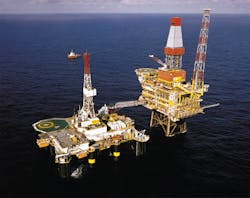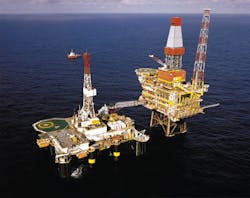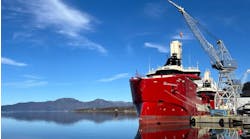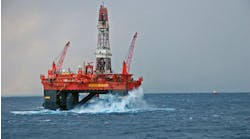Steps include operating cost cuts, injection, horizontal drainage
Arnaud Breuillac, Heather Murray
Total Oil Marine - UK
Dunbar platform and Sedco 706 operating on the Dunbar field.Alwyn Area is Total Oil Marine's core area, providing more than half of the firm's production in 1998 and more than two-thirds of the firm's remaining reserves. Total Oil Marine and Elf Exploration UK are associated in the Alwyn area joint ventures with the following interests: Total 33.33% (operator) and Elf 66.67%.
Over the past three years, the Alwyn Area has seen a number of major successes which should prolong the production plateau to 2005 and extend the expected life of the fields to beyond 2015. To achieve this objective, a number of new developments have been launched or are being studied.
Alwyn North Field was discovered in 1975 and oil and gas production started by end-1987. Initial oil production was above 100,000 b/d, and the gas export capacity was 9 cu m/d to fulfill the maximum daily delivery requirement to British Gas under a long term gas sales contract.
The Alwyn South Area, consisting of Dunbar and Ellon fields, was developed later as a satellite of Alwyn North twin platforms. Pro duction of first hydrocarbons from Dunbar plat form wells and Ellon subsea well commenced at the end of 1994. The Dunbar project philosophy was to make maximum use of existing Alwyn North facilities and infra structure.
Under this concept, a four-legged jacket with minimum topside processing facilities was chosen. A tender-assisted drill ing (TAD) concept was selected with the semisubmersible rig Sedco 706 bridge-linked to the Dunbar platform for the development drilling phase.
To avoid topsides separation, the Dunbar and Ellon production is commingled and exported via a 22-km, 16-in. multiphase insulated pipeline to Alwyn North where receiving facilities were installed. The Ellon Field was developed with twin subsea wells tied back to Dunbar platform.
Soon after Dunbar startup, it was recognized that after a short plateau, oil production from Dunbar and Ellon would decline, and as a result, the operating unit cost would increase. At that point, it was decided to undertake focused business planning and to complete a systematic review of all opportunities and constraints with the objective of not only reducing the operating unit cost but also maximizing life of field value. The results of this review could be divided into two main categories: action to reduce operating expenditures and action to increase production and reserves.
Operating costs
Before embarking on serious cost reductions, it was clear that, to protect long term performance, a number of quality measures would need to be maintained. The first of these was the need to set up very high safety standards. A clear message was cascaded to anyone working on the asset that "safe behavior is sound business."Staff at all levels were encouraged to actively participate in improving safety performance. After a review of the main cost drivers, it was also decided to maintain a high quality of maintenance with experienced personnel in order to ensure that the facilities will be available until the end of expected field life without major refurbishment.
Another action specific to Dunbar platform was to ensure that new projects would not jeopardize the minimum manning concept with a core crew of 15 multi-skilled personnel. In parallel with this, a new objective-oriented culture was put into place during the restructuring of the company into "Business Units."
A number of cost savings were generated by the new culture (pooling of logistic resources, condition based maintenance, improved planning, etc.) and a drive for continuous improvement is now well integrated into the organization at all levels. Realistic expenditure targets were set from industry benchmarks and stretch targets were set for every main cost center.
On the commercial side, a new transportation and processing agreement was negotiated with the Brent pipeline system and a new Alwyn liquid export pipeline was installed between Alwyn and Shell-operated Cormorant Alpha platform. This new export route will provide a cost-effective transportation facility for the long term.
As a result of the above, it was possible to operate the new offshore complex made of the existing Alwyn North twin platforms, the new Dunbar platform, and Ellon subsea facilities with the same operating budget as before Dunbar startup. This budget should not change significantly with the current developments for the duration of the plan.
Production and reserves
Under the second category, many opportunities were identified to increase production and reserves and therefore to compensate for the natural production decline.- Oil side: Encouraging results from the Dunbar development drilling campaign identified the potential to accelerate production and increase oil recovery by increasing the volume of water injected into the reservoirs.
As a result, a project was launched in 1997 and a new water injection pump was installed and started within a year, raising the Dunbar water injection capacity from 50,000 b/d of water to 85,000 b/d. As Dunbar wellhead flowing pressures will eventually decline with the advent of water breakthrough, a pressure boosting scheme is required to maintain oil production.
An innovative scheme involving the installation of multiphase pumps on Dunbar was chosen in line with the minimum facilities philosophy. This will boost the production from end 1999 onwards and add reserves from Alwyn South while maintaining the minimum manning concept on the Dunbar platform.
Following completion of the 20-well development drilling campaign in 1998, a further eight potential targets have been identified. Six of these wells will target untapped panels and unswept areas of Dunbar Main. In addition, following encouraging results from a pilot well in which a 1,000-meter lateral drain was drilled in late 1997, some of these wells will also target recovery from Dunbar tight zones.
This will involve drilling of multi-lateral and horizontal drains. The final two wells of the eight are planned to be appraisal wells for the as-yet-undeveloped Dunbar South panels. The first of these wells will be spudded September with an extended reach profile (ERP) with a total length of 7,300 meters. Results from these platform appraisal wells will be used to optimize subsea development of Dunbar South.
On Alwyn North, an en hanced oil recovery (EOR) project by miscible gas injection was approved in mid-1997. After extensive laboratory and reservoir studies, miscibility had been confirmed between injected Alwyn North gas (export quality) and Brent oil at reservoir conditions.
Gas injection of around 3.3 MMcm/d into three different reservoirs over a period of four years will start in April 1999. It is estimated that, as a result, the oil recovery from these reservoirs will be increased by 8% from 54% to 62%.
A complete 3D seismic reinterpretation of the area was undertaken in 1997 and after some studies, two infill targets were identified in the Brent reservoirs. Both wells were drilled from Alwyn North drilling rig by the beginning of 1998. For one of them, a new automated rotary steering system was used. This tool includes a full logging while drilling (LWD) sensor package, which reads the bottom hole assembly position within the formation, and the rotary steering system adjusts the well trajectory while drilling.
In that particular well, a total of 1,008 meters of formation were cut in 137 hours. Further sub-surface studies are continuing and it is anticipated that three to four new infill targets may be identified in the Brent reservoirs. The possibility of using coiled tubing drilling techniques for some of these wells is under study.
- Gas side: In 1995, a very significant gas accumulation was discovered in the deeper Triassic horizon underlying the existing Alwyn North Brent and Statfjord reservoirs. The deregulation of the UK gas market has also provided a strong incentive to accelerate gas developments.
Three Triassic exploration and appraisal wells have been drilled from the platform and connected for production via an early production systems (EPS). A fourth is currently being drilled and is planned for startup this summer. Using the encouraging results from this extended testing period, an optimum full field development plan for the Triassic is being finalized.
This is expected to consist of a further six to eight wells in addition to the four existing wells, making a total of 10 to 12 wells to drain the Triassic reserves. While most of these wells can be drilled from Alwyn North platform, they will be challenging (e.g. total drilled lengths of up to 7,400-7,800 meters drilling through depleted sands) and at the limit of the platform rig capabilities. Those not feasible from the platform will be subsea wells tied back to Alwyn North with new subsea facilities.
Improved recovery methods under con sideration are sand fracturation and multi-lateral drains. Results from fracturation jobs planned on two of the four existing wells this summer will be critical in realizing this upside potential.
Bottlenecks
To ensure that this additional gas can be produced without facilities constraint, debottle necking of the gas dehydration system is planned in 1999, to at least 15 MMcm/d with minimal investment by changing the internals of the glycol contactor.In parallel, a bottleneck was identified on the associated gas compression system whereby some wells producing from the Statfjord gas-condensate reservoir under natural depletion could no longer flow on the high pressure manifold. A project is being studied to add a third LP compression train to raise the pressure to 70 bar from 30.
Following positive results from a subsea well drilled on the Grant field in early 1998, the well is being connected for production via one of the existing Ellon flowlines. Remaining production from the two Ellon wells is commingled in the other flowline.
The debottlenecking of the NAB gas plant may provide an opportunity to accelerate the development of Nuggests (Northern Under water Gas Gathering Export and Treatment System) and consequently improve the value of these four gas accumulations located to the South of Dunbar.
All the above developments have been made possible by a systematic business approach to new opportunities guided by a very clear development strategy which is structured in the Alwyn area business plan. This plan has been produced annually for the last three years and it has proven to be a very useful tool for the operator and the JV partner to prioritise the various development options and to maximise the value from the assets.
The development strategy is as follows :
- Pursue incremental liquids production opportunities as soon as possible where economic
- Evaluate and prioritize gas developments in order to determine an optimized development program to maximize the use of the Alwyn gas export capacity
- Carry out in a timely manner developments that are required to configure the facilities appropriately for future production or to meet commercial opportunities.
Also, a more proactive approach has been taken on product valuation, and a simple business model has been created to maximize the netback value of products (stabilized crude oil, LPG and sales gas) through the two export systems. This model is fed with product market prices, transportation and processing costs via both the liquid and gas export systems so that offshore process parameters can be adjusted to maximize value.
In summary, a significant number of new projects using new technology have been launched or are under study in the Alwyn area with an objective of maximizing the value of the assets. Under the current three-year work program, the capital expenditure will be approximately £120 million per annum.
This investment should lead to an increase of recoverable reserves and should maintain the production plateau at 45-50 Mboe per year until 2005. Operating expenditure has progressively improved to upper quartile performance and is expected to stay there.
Authors
Arnaud Breuillac jointed Total Exploration Production (Paris) in 1982. He has been employed as a process engineer, production superintendent on Alwyn, head of field development planning in Indonesia, and supply and planning manager for the Normandy refinery in Paris before his current assignment as Alwyn area commercial manager.Heather Murray began her career as a reservoir engineer with Esso Exploration & Production UK in 1984. She joined Total Oil Marine in 1986 and has since been employed as a reservoir engineer for Alwyn North and in Total Indonesia, technical coordinator in Paris, Caister-Murdoch subsurface team leader, and most recently as head of Alwyn area developments.
Copyright 1998 Oil & Gas Journal. All Rights Reserved.




